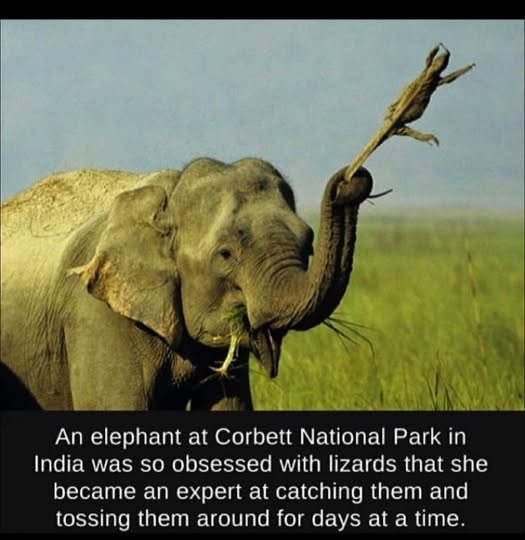
Corbett National Park, nestled in the foothills of the Himalayas in northern India, is a place where nature’s raw beauty thrives. Known for its diverse wildlife, including tigers, leopards, and elephants, the park is a haven for animal enthusiasts and researchers alike. But within this magnificent reserve, there exists a story that goes beyond the usual animal behaviors we come to expect—one of an elephant whose actions baffled and amused park rangers, researchers, and visitors alike.
This story revolves around an elephant whose obsession with lizards became one of the most talked-about phenomena within the park. Her behavior was so unique, so bizarre, that it captured the attention of anyone fortunate enough to witness it. The elephant wasn’t just curious about lizards—she was fixated on them, developing a skill for hunting them that would leave many amazed, especially given the vast size difference between her and her prey.
The Elephant’s Obsession: Curiosity Turned into a Skill
It started with a few fleeting moments observed by the park rangers: the elephant, with her massive body and lumbering gait, would occasionally pause and focus her attention on the ground. At first, it seemed like any ordinary behavior for an elephant, who often forages for food or investigates its surroundings. But over time, the park rangers noticed a pattern. The elephant wasn’t just sniffing or exploring the forest floor; she seemed to be looking for something specific—and that something was small, fast-moving creatures.
Upon closer observation, the rangers realized that this elephant had developed an incredible knack for spotting lizards. Not only did she seem to be able to detect them from afar, but she also demonstrated remarkable precision in capturing them. Using her trunk, she would reach out, gently but quickly, and snatch up the small reptiles with surprising accuracy. It was as if she had learned to recognize the tiny creatures, anticipating their movements and responding with practiced grace.
At first, the behavior was seen as a curious fluke—something that might fade over time. But the elephant’s fascination only deepened. Over days and weeks, her fixation with lizards became more apparent. She would spend hours at a time in certain areas of the park, often returning to the same spots, as if she knew exactly where to find her prey. Her behavior was no longer just about curiosity; it was about obsession, something that intrigued the park rangers to no end.
A Gentle Game of Toss and Fetch
What truly set this elephant apart, however, was what happened after she caught a lizard. Instead of quickly devouring or discarding her catch, she did something unusual: she would toss the lizard gently into the air and then watch it fall. The lizard, often disoriented, would scramble to get away, but before it could escape, the elephant would nudge it with her trunk and repeat the process. Sometimes, she would follow the lizard as it tried to flee, almost as if playing a game.
This repetitive behavior was not an act of aggression. The elephant did not show any signs of wanting to harm the lizards; rather, it seemed to be an entertainment ritual. The rangers noted how she appeared to enjoy the process of tossing the lizards, following them around, and repeating the behavior for hours. In some instances, the elephant would spend days in a single location, indulging in her odd pastime, as though she was completely absorbed in her own world of lizard play.
Such behavior was unprecedented. Elephants are known to be intelligent creatures with complex social structures, but this was something that had never been documented before. Most elephants spend their time foraging for food, socializing with other members of their herd, or performing routine activities. But this particular elephant had carved out her own niche in the wild, one that was as quirky as it was fascinating.
A Study in Individuality
What made the elephant’s lizard fixation even more interesting was the fact that it highlighted something fundamental about animal behavior: the individuality of each creature. Just as humans have different personalities, preferences, and quirks, so do animals. The elephant’s obsession with lizards was not a behavior shared by other elephants in the park. In fact, her behavior was so unique that it became something of a legend within Corbett National Park.
Researchers and rangers alike were astounded by the elephant’s persistence. They noted that the behavior did not seem to stem from a need for nourishment, as the elephant was not hunting the lizards for food. Instead, it appeared to be a self-generated pastime, something that brought her joy or satisfaction. The complexity of her behavior raised intriguing questions about the emotional and psychological lives of animals.
Could it be that the elephant, much like a human, simply enjoyed the thrill of a repetitive, engaging activity? Was she experiencing something akin to amusement, as a person might when playing a game? Or was it a form of mental stimulation, perhaps something to alleviate boredom or stress? These are questions that researchers could only speculate about, as the true nature of the elephant’s motivations remained a mystery.
The Elephant as a Symbol of the Complexity of Animal Behavior
This story of the elephant and her lizards serves as a poignant reminder of the complexities of animal behavior. It challenges the simplistic views many people have about animals, suggesting that they are little more than instinct-driven beings. In reality, animals—especially highly intelligent species like elephants—are capable of a wide range of emotions and behaviors that we are only beginning to understand.
What makes this elephant’s story so fascinating is that it exemplifies the unexpected depth of personality that can exist even within non-human creatures. While elephants are known for their social bonds and impressive memories, this particular elephant demonstrated an independent streak, pursuing an activity that was entirely her own. She did not rely on her herd for companionship or engagement; instead, she found solace in the repetitive motions of her lizard-chasing game.
Moreover, this behavior sheds light on the adaptability of elephants. Known for their incredible problem-solving abilities and emotional intelligence, elephants are also highly adaptable creatures that can adjust to different environments and circumstances. This elephant’s ability to invent her own form of entertainment is a testament to her capacity for creativity and personal expression. In a way, her lizard fixation was a form of self-care—an activity that helped her maintain mental and emotional well-being in an environment where such indulgences are rare.
The Legacy of the Lizard-Loving Elephant
As the years went by, the legend of the lizard-loving elephant grew. Researchers continued to observe her behavior, fascinated by the persistence and consistency with which she engaged in her quirky pastime. The story spread beyond the park, capturing the imaginations of wildlife enthusiasts and animal lovers around the world. People marveled at the elephant’s ability to turn such a mundane activity—catching lizards—into something extraordinary.
For the rangers and researchers who witnessed the behavior firsthand, the elephant became a symbol of the unpredictability and wonder of nature. In a world where so many animals are studied in terms of survival instincts and ecological roles, her actions reminded everyone that the animal kingdom is filled with surprises—many of which have nothing to do with survival and everything to do with the simple joys of life.
Her story also reinforced a critical point: that animals, like humans, are individuals with their own personalities, preferences, and desires. This elephant was not a mere representative of her species; she was an individual with quirks and habits that made her unique. Whether it was play, curiosity, or simply her own version of fun, her behavior served as a reminder of the richness of life in the animal kingdom.



Good https://lc.cx/xjXBQT
Awesome https://lc.cx/xjXBQT
Awesome https://lc.cx/xjXBQT
Awesome https://lc.cx/xjXBQT
Very good https://lc.cx/xjXBQT